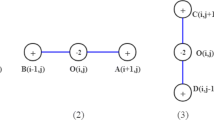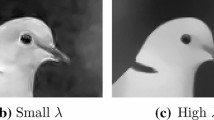Abstract
Image denoising is one of the challenging topics in image processing. Since the formation mechanism of the degraded image is unknown, it is difficult to achieve effective image denoising. Most existing denoising methods are easy to blur the edges of the image so that it is difficult to maintain more image detail information. In recent years, partial differential equation (PDE) has been applied to image denoising, which has shown good application prospects. However, the image denoising methods based on PDE are easy to appear staircase effect and edge blur, and can not achieve satisfactory denoising effect. To avoid some problems, an adaptive variational PDE (VPDE) image denoising model based on the structure tensor is proposed and analyzed. In the proposed model, since the structure tensor can provide more local structural information and direction information of the gradient, the eigenvalues of the structure tensor of an image are used to construct the norm parameter. Through theoretical analysis and experiments, we can confirm that the proposed norm parameter has the following adaptive characteristics: (1) In the flat region of the image, the proposed norm parameter tends to 2, so which has the characteristic of isotropic diffusion. (2) At the edge region of the image, the norm parameter tends to 1, and which spreads only along the tangential direction of the image edge. The experimental results from both subjective and objective aspects show that using these adaptive characteristics, the proposed image denoising model can effectively avoid staircase effect, preserve the image details, and obtain satisfactory denoising effect.













Similar content being viewed by others
References
Abdelgader S, Zhichang G, Zhenyu Z et al (2018) An image denoising model based on a fourth-order nonlinear partial differential equation. Comput Math Appl 76(5):1056–1074
Brox T, Weickert J, Burgeth B et al (2006) Nolinear structure tensors. Image Vis Comput 24(1):41–55
Burger W, Burge MJ (2016) Digital image processing: an algorithmic introduction using Java. Springer
Chen Q, Montesinos P, Sun QS et al (2010) Adaptive total variation denoising based on difference curvature. Image Vis Comput 28(3):298–306
Chen Y, Yu W, Pock T (2015) On learning optimized reaction diffusion processes for effective image restoration. 2015 IEEE conference on computer vision and pattern recognition, 7-12 July, Boston, USA, 5261-5269
Chierchia G, Pustelnik N, Pesquet-Popescu B et al (2014) A nonlocal structure tensor-based approach for multicomponent image recovery problems. IEEE Trans Image Process 23(12):5531–5544
Drogoul A, Aubert G (2017) The topological gradient method for semi-linear problems and application to edge detection and noise removal. Inverse Prob Imaging 10(1):51–86
Duran J, Moeller M, Sbert C, et al. (2015) A novel framework for nonlocal vectorial total variation based on Lp, q, r-norms. International workshop on energy minimization methods in computer vision and pattern recognition. Springer, Cham, 141-154
Estellers V, Soatto S, Bresson X (2015) Adaptive regularization with the structure tensor. IEEE Trans Image Process 24(6):1777–1790
Everts I, Van Gemert JC, Gevers T (2014) Evaluation of color spatio-temporal interest points for human action recognition. IEEE Trans Image Process 23(4):1569–1580
Jin C, Yan M, Jin SW (2013) An approach to remove impulse noise from a corrupted image. J Opt 15(2):1–8
Kamalaveni V, Veni S, Narayanankutty KA (2017) Improved self-snake based anisotropic diffusion model for edge preserving image denoising using structure tensor. Multimed Tools Appl 76(18):1–32
Lefkimmiatis S, Osher S (2015) Nonlocal structure tensor functionals for image regularization. IEEE Trans Comput Imaging 1(1):16–29
Lefkimmiatis S, Roussos A, Unser M, et al (2013) Convex generalizations of total variation based on the structure tensor with applications to inverse problems. International Conference on Scale Space and Variational Methods in Computer Vision, 2-6 June, Leibnitz, Austria, 48-60
Lefkimmiatis S, Roussos A, Maragos P et al (2015) Structure tensor total variation. SIAM J Imaging Sci 8(2):1090–1122
Li B, Su ZX, Liu ZP (2008) An adaptive PDE image processing method based on Lp norm. Acta Automat Sin 34(8):849–853
Li B, Lv J, Luo X et al (2019) A novel and fast nonlocal means denoising algorithm using a structure tensor. J Supercomput 75(2):770–782
Liu D, Wen B H, Liu X M, et al. (2018) When image denoising meets high-level vision tasks: a deep learning approach. 27Th International Joint Conferences on Artificial Intelligence, 13-19 July, Stockholm, Sweden, 842-848
Liu Y, Shan C, Gao Q et al (2019) Hyperspectral image denoising via minimizing the partial sum of singular values and superpixel segmentation. Neurocomputing 330:465–482
Lu ZL (2012) Research on image restoration technology based on partial differential equation theory. China University of Mining and Technology, PhD thesis, Xuzhou, China
Pu YF, Siarry P, Zhou JL et al (2014) A fractional partial differential equation based multiscale denoising model for texture image. Math Methods Appl Sci 37(12):1784–1806
Shahdoosti HR, Mehrabi A (2018) MRI and PET image fusion using structure tensor and dual ripplet-II transform. Multimed Tools Appl 77(17):22649–22670
Shi Z, Xu B, Xia Z et al (2017) A Chinese character structure preserved denoising method for Chinese tablet calligraphy document images based on KSVD dictionary learning. Multimed Tools Appl 76(13):14921–14936
Song B (2003) Topics in variational PDE image segmentation, inpainting and denoising. University of California Los angels, PhD thesis, USA
Song X, Feng F, Liu J, et al. Neurostylist: neural compatibility modeling for clothing matching. The 25th ACM International Conference on Multimedia, 23-27 October 2017, Mountain View, USA, 753-761
Talebi H, Milanfar P (2014) Global image denoising. IEEE Trans Image Process 23(2):755–768
Tao D, Song M, Li X et al (2008) Bayesian tensor approach for 3-D face modeling. IEEE Trans Circuits Syst Video Technol 18(10):1397–1410
Tikhonov AN, Goncharsky AV, Stepanov VV, et al (2013) Numerical methods for the solution of ill-posed problems. Springer Science & Business Media
Tu Z, Xie W, Cao J et al (May 2017) Variational method for joint optical flow estimation and edge-aware image restoration. Pattern Recogn 65:11–25
Weickert J (1998) Anisotropic diffusion in image processing. Teubner, Stuttgart
Wright J, Pless R (2005) Analysis of persistent motion patterns using the 3D structure tensor. Seventh IEEE workshops on application of computer vision, 5-7 January, Breckenridge, USA, 14-19
Xie JY, Xu L, Chen EH (2012) Image denoising and inpainting with deep neural networks. The 25th international conference on neural information processing systems. 306 December, Lake Tahoe, Nevada, USA, 341-349
Xu J, Hao Y, Li M et al (2019) A novel variational model for image decomposition. SIViP. https://doi.org/10.1007/s11760-019-01434-3
Yan J, Lu WS (2015) Image denoising by generalized total variation regularization and least squares fidelity. Multidim Syst Sign Process 26(1):243–266
Yang JF, Gu GY, Jiang SH (2017) A TVSCAD approach for image deblurring with impulsive noise. Inverse Prob 33(12):1–21
Yang L, He C, Wu Y (July 2018) Variational model with kernel metric-based data term for noisy image segmentation. Digital Signal Process 78:42–55
Yuan Q, Zhang L, Shen H (2012) Hyperspectral image denoising employing a spectral-spatial adaptive total variation model. IEEE Trans Geosci Remote Sens 50(10):3660–3677
Zeng W, Lu X, Tan X (2015) A local structural adaptive partial differential equation for image denoising. Multimed Tools Appl 74(3):743–757
Zhang HY, Peng QZ (2006) Adaptive image denoising model based on total variation. Opto-Electron Eng 33(3):50–53
Zheng YH, Zhu LX, Wei ZH et al (2008) An adaptive fidelity term for total variation denoising method using local structure information. J Comput Aided Des Comput Graph 20(4):506–511
Author information
Authors and Affiliations
Corresponding author
Additional information
Publisher’s note
Springer Nature remains neutral with regard to jurisdictional claims in published maps and institutional affiliations.
Rights and permissions
About this article
Cite this article
Jin, C., Li, Q. & Jin, SW. An adaptive VPDE image denoising model based on structure tensor. Multimed Tools Appl 78, 28331–28354 (2019). https://doi.org/10.1007/s11042-019-07912-7
Received:
Revised:
Accepted:
Published:
Issue Date:
DOI: https://doi.org/10.1007/s11042-019-07912-7




